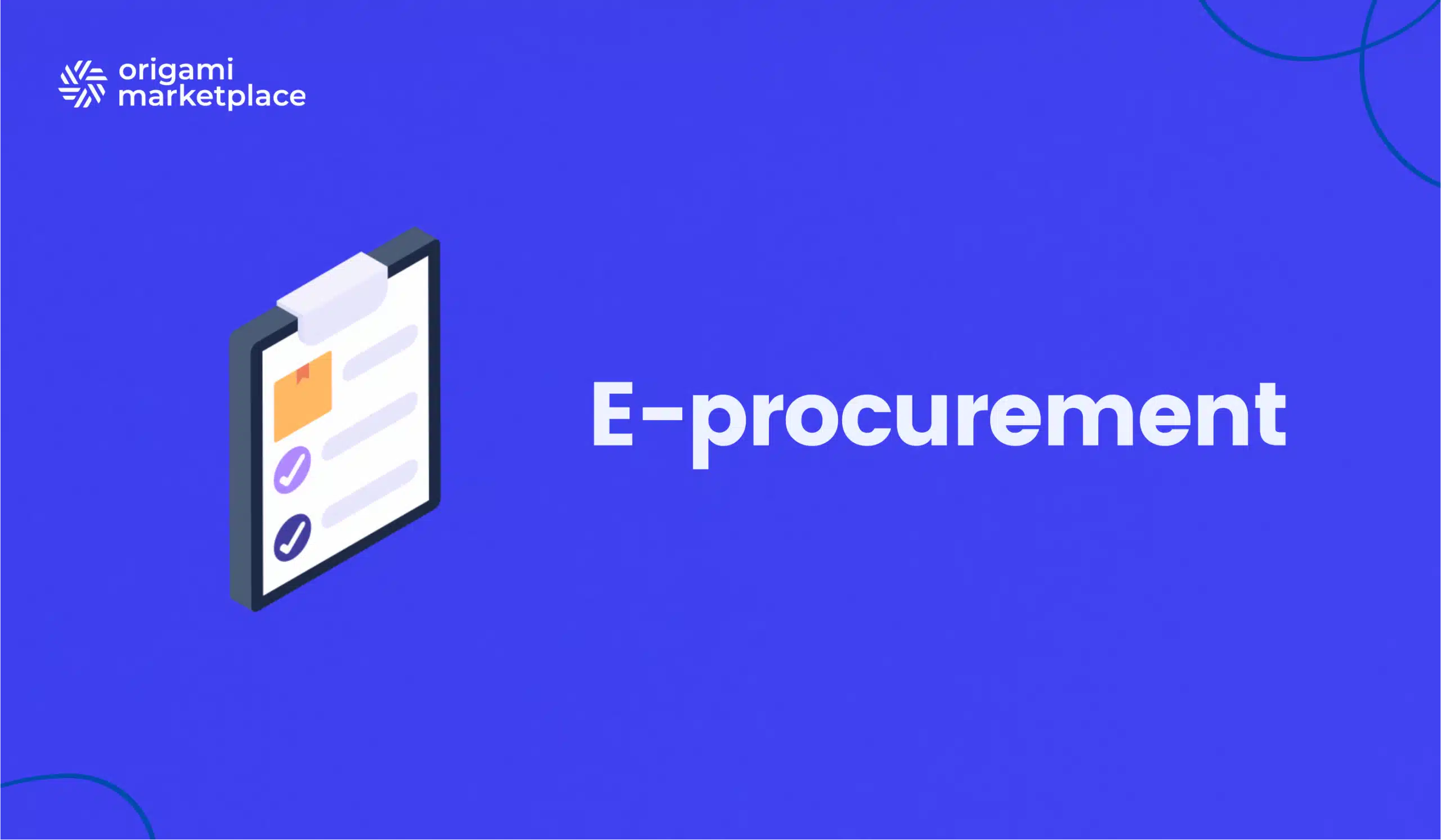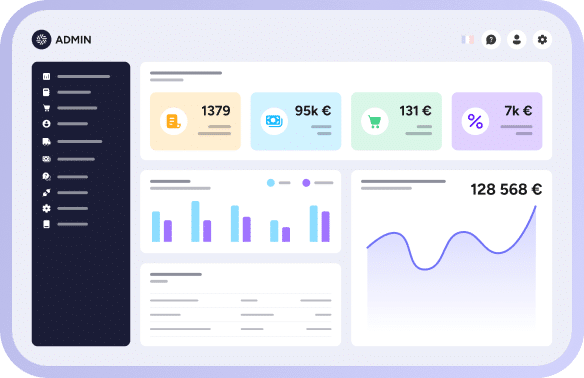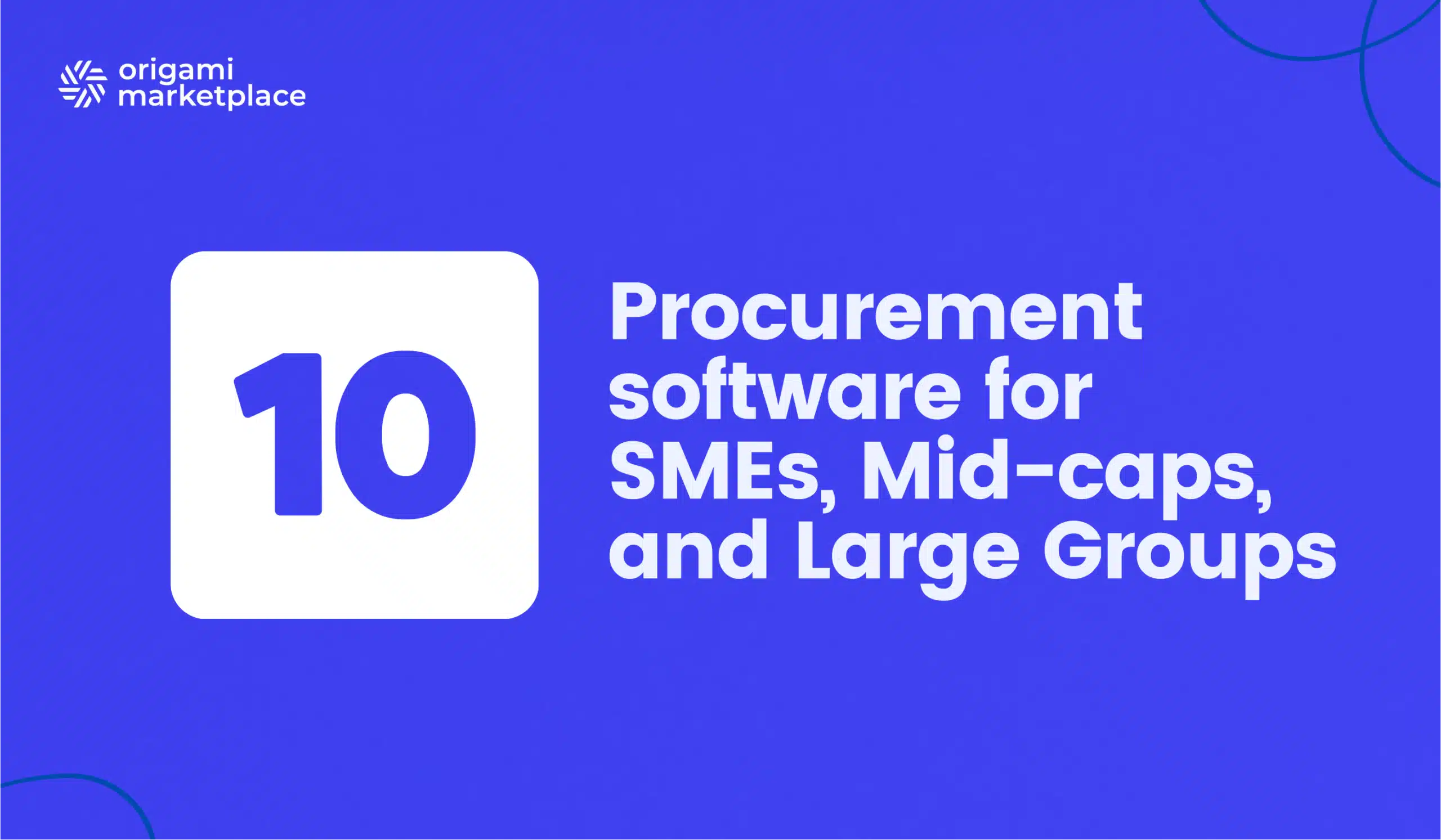E-Procurement: Definition, How it Works & Benefits 🛒
- Arnaud
- 9 minutes reading

E-procurement, or electronic procurement, today represents an essential strategic lever for companies seeking to optimize their supply chain. In an economic context marked by inflation and supply challenges, the digitalization of B2B purchasing is emerging as an effective solution to reduce costs and improve operational efficiency.
The adoption of e-procurement technologies is experiencing exponential growth, with particular attention paid to the integration of artificial intelligence. According to The State of ePayables 2024 d’Ardent Partners report, 31% of procurement departments are already using AI, a rate expected to climb to 76% within a year, illustrating the rapid rise of its adoption in e-procurement.
E-procurement integrates information and communication technologies into the purchasing process to increase its performance, transparency, and traceability. It is fully part of a digital transformation strategy for procurement and finance functions, addressing the growing needs for automation and expenditure optimization in an increasingly complex B2B environment.
In this article, we will explore in detail what e-procurement is, how it works, its quantified benefits, and best practices for its implementation within your organization.
👋 No time to read the whole article? Find the article summary here.
1. What is e-Procurement?
E-procurement refers to the use of digital solutions to manage the entire purchasing cycle of goods and services within a company. This term, derived from “electronic procurement,” encompasses all stages of the supply process, from identifying needs to selecting suppliers, including ordering, invoicing, and payment. Concretely, it involves the digitalization of B2B (Business to Business) commercial interactions with the aim of optimizing procurement processes.
According to the 2023 Annual Barometer on the success of the digital transformation of Procurement Departments, 92% of decision-makers believe that digitalization represents an opportunity to increase the added value of the procurement function, highlighting the growing importance of e-procurement in the current economic landscape.
The different facets of e-procurement:
The concept of e-procurement covers different complementary facets, each addressing a specific part of the purchasing process:
- E-sourcing: The online search and selection of suppliers, including electronic calls for tenders (e-tendering) and reverse auctions (e-auctions). This crucial step allows for the identification of the best commercial partners based on predefined criteria such as price, quality, or delivery times.
- E-purchasing: The operational management of orders via electronic catalogs, the creation and tracking of purchase orders, as well as the management of receipts. This component facilitates daily purchases by automating repetitive processes.
- Procure-to-Pay (P2P): The integration of the entire process, from the purchase request to the payment of the invoice, including document matching. This end-to-end approach ensures continuity and consistency throughout the entire procurement cycle.
E-procurement solutions generally come in the form of dedicated software or online platforms that centralize information and facilitate collaboration between different internal stakeholders (requesters, procurement department, accounting) and external ones (suppliers).
To delve deeper into the subject and discover in detail the differences between Procure-to-Pay, Purchase-to-Pay, and Source-to-Pay, consult our complete guide here.
Discover how our multi-vendor purchasing solution can transform your procurement process into a strategic lever. Benefit from simplified management, better visibility on your expenses, and a rapid return on investment.

The purchasing lifecycle in a digitized environment:
In a digitized environment, the purchasing lifecycle follows an optimized path that allows for efficiency gains at each stage:
- Identification and expression of need: End-users can easily express their needs via standardized electronic forms.
- Supplier research and selection: E-sourcing allows for the rapid identification of the most suitable suppliers thanks to enriched databases and comparison tools.
- Negotiation and contracting: E-procurement platforms facilitate negotiations and contract management, with electronic signature and secure archiving functionalities.
- Ordering and supply: Orders are generated automatically and transmitted electronically to suppliers, reducing delays and errors.
- Reception and control: The reception of goods or services is recorded in the system, allowing for real-time tracking.
- Invoicing and payment: The dematerialization of invoices and the automation of payments accelerate the settlement process.
- Analysis and continuous improvement: Data collected throughout the process allows for performance analysis and identification of areas for improvement.
This digitalization of the purchasing lifecycle not only reduces delays and costs but also improves the traceability and transparency of procurement operations.
2. How the e-Procurement process works
The e-procurement process relies on the complete digitalization of the B2B supply chain, enabling the automation and optimization of each stage of the purchasing cycle. This digital transformation of purchasing is structured around three main phases, all supported by specific technologies that facilitate interactions between the company and its suppliers.
Step 1: Product selection via electronic catalogs and Punch-Out
The first step in the e-procurement process is to select the necessary products or services. For this, companies have several options:
- Internal electronic catalogs: These catalogs centralize the negotiated offer with referenced suppliers and are directly integrated into the company’s purchasing system. They allow users to easily consult available products, their characteristics, and their prices.
- Punch-Out systems: This interface directly connects the company’s purchasing system to the supplier’s website, allowing users to access the supplier’s complete and updated offer in real-time. The use of Punch-Out systems can reduce product search time by an average of 35%.
- B2B Marketplaces: These professional marketplaces bring together several suppliers and offer a wide choice of products and services, facilitating comparison and selection.
Once the products are selected, the user creates a purchase request that is automatically integrated into the system to follow the predefined validation circuit. This dematerialization eliminates paper forms and considerably speeds up the request process.
Step 2: Automation of orders and validation
After validation by authorized persons (according to defined governance rules), the purchase request automatically transforms into a purchase order. This crucial stage of the electronic procurement process benefits from several advantages linked to digitalization:
- Automated validation workflows: Requests follow a predefined path based on criteria such as amount, purchase category, or department, ensuring compliance with the company’s purchasing policies.
- Electronic transmission of orders: The purchase order is sent instantly to the supplier in electronic form (EDI, XML, email) or via an exchange platform, eliminating postal delays and the risk of data entry errors.
- Complete traceability: Each action is timestamped and associated with its author, creating a complete audit trail and facilitating order tracking.
Automating this step can reduce order processing time by 65% and eliminate up to 90% of errors related to manual entry.
Step 3: Dematerialized management of invoices and payments
The final stage of the e-procurement process concerns the reception of goods, invoicing, and payment:
- Digitalized reception: Delivery is recorded electronically in the system, allowing for automatic reconciliation with the purchase order.
- Electronic invoicing: Invoices are received in electronic format (PDF or EDI), certified by a trusted third party, and automatically integrated into the accounting system. This dematerialization is all the more relevant as electronic invoicing is progressively becoming mandatory in many countries, including France.
- Automatic reconciliation: The system automatically compares the order, the delivery note, and the invoice (3-way matching), instantly identifying any discrepancies.
- Optimized payment: Once validated, the invoice automatically triggers the payment process according to the conditions negotiated with the supplier.
This complete digitalization of the Procure-to-Pay (P2P) process not only considerably reduces processing times but also improves supplier relations thanks to faster and more reliable payments.
Adopt an innovative multi-vendor purchasing solution that integrates perfectly with your existing systems. Benefit from an intuitive interface, automation of repetitive tasks, and enhanced collaboration with your suppliers.

3. The strategic advantages of e-Procurement
The adoption of e-procurement solutions offers considerable benefits for companies, with measurable impacts on financial and operational performance. Here is a detailed analysis of the main advantages, supported by recent figures.
Cost reduction and expenditure optimization:
Optimizing purchasing processes through e-procurement translates into substantial savings at several levels.
- Lower administrative processing costs: Automating purchasing processes significantly reduces operational costs.
- Savings on transactions: The costs of a standard transaction are estimated at an average of €95, while those of a 100% digital transaction (from product selection to payment) drop to less than €19. For a company processing thousands of orders annually, savings can reach several hundred thousand euros.
- Access to negotiated rates and reduced expenses: The use of online catalogs and facilitated competition can lead to savings on direct purchase prices.
- Decrease in off-contract purchases (maverick buying): Automation and standardization of processes reduce non-compliant purchases, thereby improving adherence to purchasing policies.
Improved operational efficiency and automation:
The digitalization of purchasing processes significantly optimizes operational efficiency, particularly with AI. According to the Procurement Metrics that Matter in 2024 report, 74% of chief procurement officers plan to use AI by the end of 2024.
- Acceleration of procurement cycles: The integration of AI into procurement processes has led to improvements in productivity, quality, and cost savings.
- Dematerialization of flows and documents: This frees up valuable time for teams.
- Error reduction: Process automation reduces the error rate, thus decreasing the time spent on corrections and disputes.
- Refocusing on value-added tasks: Buyers and finance teams can concentrate on strategic missions (spend analysis, negotiation, risk management) rather than time-consuming administrative tasks, increasing their contribution to the company’s overall performance.
Increased visibility and control over spend management:
E-procurement offers unprecedented transparency into company expenses.
- Real-time tracking via KPIs and dashboards: Modern e-procurement platforms provide a clear view of spending commitments and enable faster, more informed decision-making. According to the report titled Procurement Analytics Market Size, Share & Trends Analysis Report, the global procurement analytics market was valued at $2.88 billion in 2021 and is expected to reach $18.18 billion by 2030, with a CAGR of 23.6% over the period 2022–2030, testifying to the growing importance of this functionality.
- Complete audit trail for each transaction: Every action is tracked and timestamped, ensuring essential traceability for compliance, governance, and fraud prevention.
- Adherence to budgets and internal procedures: E-procurement solutions can help improve budget alignment and compliance with internal policies, with automatic alerts in case of overruns or deviations.
- Predictive spend analysis: AI technologies integrated into e-procurement platforms now allow for anticipating needs and optimizing inventory, thereby reducing holding costs and stockout risks.
Strengthened supplier relations and optimized collaboration:
E-procurement also transforms the relationship with suppliers.
- Centralized communication and exchange history: E-procurement platforms offer a single, transparent communication channel, facilitating collaboration and problem resolution.
- Supplier performance evaluation: Dedicated functionalities allow for objective monitoring, as digital and collaborative supplier management significantly improves their performance and the quality of relationships.
- Better collaboration on deadlines, quality, disputes: Thanks to integrated supplier portals and clear processes, problems are identified and resolved more quickly, strengthening mutual trust.
- Faster and more reliable payments: Automating the invoicing and payment process helps meet deadlines and improve supplier cash flow, a key factor in building lasting relationships.
Security, compliance, and risk reduction:
Finally, e-procurement significantly contributes to securing purchasing processes.
- Reinforced control over financial commitments: Approval workflows and automated controls limit unauthorized spending and ensure compliance with delegation levels.
- Compliance with regulations: Modern e-procurement solutions integrate regulatory requirements such as mandatory electronic invoicing, GDPR, or specific industry standards.
- Reduction of fraud and errors: Process automation and integrated controls considerably reduce the risks of human error and fraud.
4. Implementing an e-Procurement solution: Key steps and best practices
Implementing an e-procurement solution is a strategic project that requires a methodical and structured approach. Here are the essential steps to successfully achieve this digital transformation of your purchasing processes.
1. Needs analysis and objective definition
Before selecting a solution, it is crucial to:
- Map existing purchasing processes: Identify current workflows, friction points, and opportunities for improvement.
- Define clear and measurable objectives: Cost reduction, cycle acceleration, compliance improvement, etc.
- Involve all stakeholders: Procurement department, finance, end-users, IT, and key suppliers.
2. Selecting the right solution
The choice of e-procurement platform must align with your specific needs:
- Evaluate required functionalities: Catalogs, approval workflows, ERP integration, reporting, etc.
- Consider scalability: The solution must be able to adapt to your company’s growth.
- Analyze the total cost of ownership: Beyond the acquisition price, consider maintenance, training, and evolution costs.
- Verify technical compatibility: Ensure the solution can integrate with your existing IT ecosystem.
3. Data preparation and integration
This technical step is fundamental to the project’s success:
- Clean and structure data: Supplier repositories, product catalogs, approval rules, etc.
- Integrate with existing systems: ERP, accounting, inventory management, etc.
- Configure workflows: Define validation circuits according to your organization and governance rules.
- Set up supplier connectors: Establish technical links with your main suppliers (EDI, API, Punch-Out).
4. Change management and training
User adoption is often the key success factor:
- Communication plan: Explain the expected benefits for the company and for each user.
- Adapted training: Offer differentiated training sessions according to profiles (buyers, approvers, accountants).
- Accessible documentation: Create user guides, FAQs, and video tutorials.
- Identify ambassadors: Train key users who can then help their colleagues.
5. Progressive deployment
A phased deployment helps secure the project:
- Pilot approach: Start with a limited scope (one department, one purchasing category) to test and adjust.
- Phased rollout: Gradually extend to other entities or purchasing categories.
- Progressive supplier integration: Start with strategic or most willing suppliers.
- Continuous adjustments: Collect feedback and optimize the solution as you go.
6. Monitoring and continuous optimization
Once deployed, the solution must be managed and optimized:
- Definition and monitoring of performance indicators: Adoption rate, processing times, savings achieved, etc.
- Regular reviews: Organize progress meetings to identify areas for improvement.
- Technological watch: Stay informed about evolutions of your solution and new available functionalities.
- Scope expansion: Consider integrating new purchasing categories or new functionalities.
By following these steps methodically and paying particular attention to change management, your e-procurement project will have every chance of succeeding and bringing the expected benefits to your organization.
Many companies underestimate the potential of a good e-procurement tool. It's not just a time-saver; it's a real strategic opportunity. By centralizing purchases, you improve your visibility on spending, reduce errors, and above all, you give teams back time to focus on higher value-added tasks. A well-deployed solution means a measurable ROI in a few months

Alexandre Duquenoy
→ Discuss with our purchasing solution expert
E-procurement is much more than just a technological tool: it is a fundamental strategic lever for procurement, finance, and IT departments. In an ever-evolving economic environment, increasingly digitized and subject to strict regulations, it allows companies to significantly gain in agility, security, and overall performance. The latest studies and conferences are unequivocal: companies that have adopted electronic procurement solutions benefit from considerable competitive advantages. With significant reductions in transaction costs and substantial savings on purchased goods and services, the investment in a suitable purchasing solution is generally recouped in less than two years.
The digitalization of B2B purchasing also addresses contemporary business challenges:
- Inflation and price volatility, which require increased control over spending
- Supply chain tensions, which demand better visibility
- Growing regulatory requirements, particularly regarding electronic invoicing
- The expectations of new generations of employees, accustomed to intuitive digital interfaces
Whether it’s about saving precious time, optimizing financial resources, minimizing risks, or building stronger and more collaborative supplier relationships, e-procurement has become an indispensable standard for modern and efficient purchasing management.
Technologies continue to evolve rapidly, with the increasing integration of artificial intelligence, predictive analytics, and advanced automation. Companies that adopt these solutions now will be best positioned to leverage these innovations and maintain their competitive edge in the years to come.
Ready to transform your purchasing processes?
Evaluate the digital maturity of your procurement function and identify optimization opportunities with our personalized diagnosis. Our experts can assist you in defining your e-procurement strategy and present the most suitable solution for your specific needs.
🕒 No time to read everything? Here’s the essential in 1 minute.
E-procurement, or electronic procurement, is today an essential lever for modernizing B2B purchasing. It allows for the digitalization of the entire purchasing cycle: from defining the need to payment, by centralizing processes, reducing costs, and making exchanges with suppliers more reliable.
In a context marked by inflation, logistical tensions, and increased regulatory requirements (like electronic invoicing), companies are seeking efficiency, visibility, and automation more than ever. The figures speak for themselves :
✔️ Up to 80% savings on processing costs,
✔️65% time savings on orders,
✔️ Massive reduction in errors and off-contract purchases.
AI, already adopted by over 30% of procurement departments, is expected to become the norm by 2025. To succeed, it is above all necessary to properly scope the project, involve the teams, and choose a solution adapted to your needs.
👉Why wait? E-procurement means less paperwork, more control, and a return on investment often in less than 2 years. Discover how our multi-vendor solution can help you with your current challenges.


